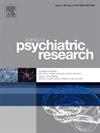Associations between social media use and positive mental health among adolescents: Findings from the Canadian Health Behaviour in School-aged Children Study
IF 3.2
2区 医学
Q1 PSYCHIATRY
引用次数: 0
Abstract
Social media use (SMU) has rapidly increased among children and adolescents in the past decade, and has been linked with poorer mental health. However, moderate SMU can facilitate connectedness among peers, which may have positive impacts for well-being – these associations are underexplored. This study examined the associations between SMU and several indicators of PMH in a nationally representative sample of 13,113 adolescents in grades 6 to 10 from the 2017/2018 cycle of the Canadian Health Behavior in School-aged Children (HBSC) study. SMU was measured using a four-level composite of intensity (non-active, active, intense) and problematic SMU (addictive-like symptoms, regardless of intensity). Four dichotomous indicators of PMH were examined: self-efficacy, self-confidence, life satisfaction, and psychological well-being. Covariates included grade, gender, cultural/racial background, and socioeconomic status. Unadjusted and adjusted mixed effects logistic regression models accounting for school-level clustering were run, with separate models for each PMH indicator and active SMU set as the referent. When compared to active SMU, problematic SMU was associated with lower levels of all PMH indicators, and intense SMU was associated with lower life satisfaction. In gender-stratified models, intense SMU was associated with lower life satisfaction among girls. In grade-stratified models, non-active SMU was associated with lower self-confidence for adolescents in grades 9 and 10. In all, problematic SMU is generally associated with lower odds of reporting high PMH. Longitudinal research is required to ascertain directionality of these findings, and to examine how these associations may have changed as a result of the COVID-19 pandemic.
社交媒体使用与青少年积极心理健康之间的关系:来自加拿大学龄儿童健康行为研究的发现。
在过去的十年中,社交媒体的使用在儿童和青少年中迅速增加,并且与较差的心理健康有关。然而,适度的SMU可以促进同伴之间的联系,这可能对幸福感产生积极影响——这些联系尚未得到充分探索。本研究在2017/2018年加拿大学龄儿童健康行为(HBSC)研究周期的全国代表性样本中,研究了SMU与PMH若干指标之间的关系。SMU采用强度(非活动、活动、强烈)和问题性SMU(与强度无关的成瘾样症状)的四级复合测量。研究了PMH的四项二分类指标:自我效能感、自信心、生活满意度和心理幸福感。协变量包括年级、性别、文化/种族背景和社会经济地位。运行考虑校级聚类的未调整和调整混合效应logistic回归模型,每个PMH指标单独建立模型,并以活跃的SMU集为参考。与积极的SMU相比,有问题的SMU与所有PMH指标水平较低有关,而强烈的SMU与较低的生活满意度有关。在性别分层模型中,强烈的SMU与女孩较低的生活满意度有关。在年级分层模型中,不活跃的SMU与9年级和10年级青少年的自信心较低有关。总之,有问题的SMU通常与报告高PMH的几率较低有关。需要进行纵向研究,以确定这些发现的方向性,并研究这些关联如何因COVID-19大流行而发生变化。
本文章由计算机程序翻译,如有差异,请以英文原文为准。
求助全文
约1分钟内获得全文
求助全文
来源期刊

Journal of psychiatric research
医学-精神病学
CiteScore
7.30
自引率
2.10%
发文量
622
审稿时长
130 days
期刊介绍:
Founded in 1961 to report on the latest work in psychiatry and cognate disciplines, the Journal of Psychiatric Research is dedicated to innovative and timely studies of four important areas of research:
(1) clinical studies of all disciplines relating to psychiatric illness, as well as normal human behaviour, including biochemical, physiological, genetic, environmental, social, psychological and epidemiological factors;
(2) basic studies pertaining to psychiatry in such fields as neuropsychopharmacology, neuroendocrinology, electrophysiology, genetics, experimental psychology and epidemiology;
(3) the growing application of clinical laboratory techniques in psychiatry, including imagery and spectroscopy of the brain, molecular biology and computer sciences;
 求助内容:
求助内容: 应助结果提醒方式:
应助结果提醒方式:


